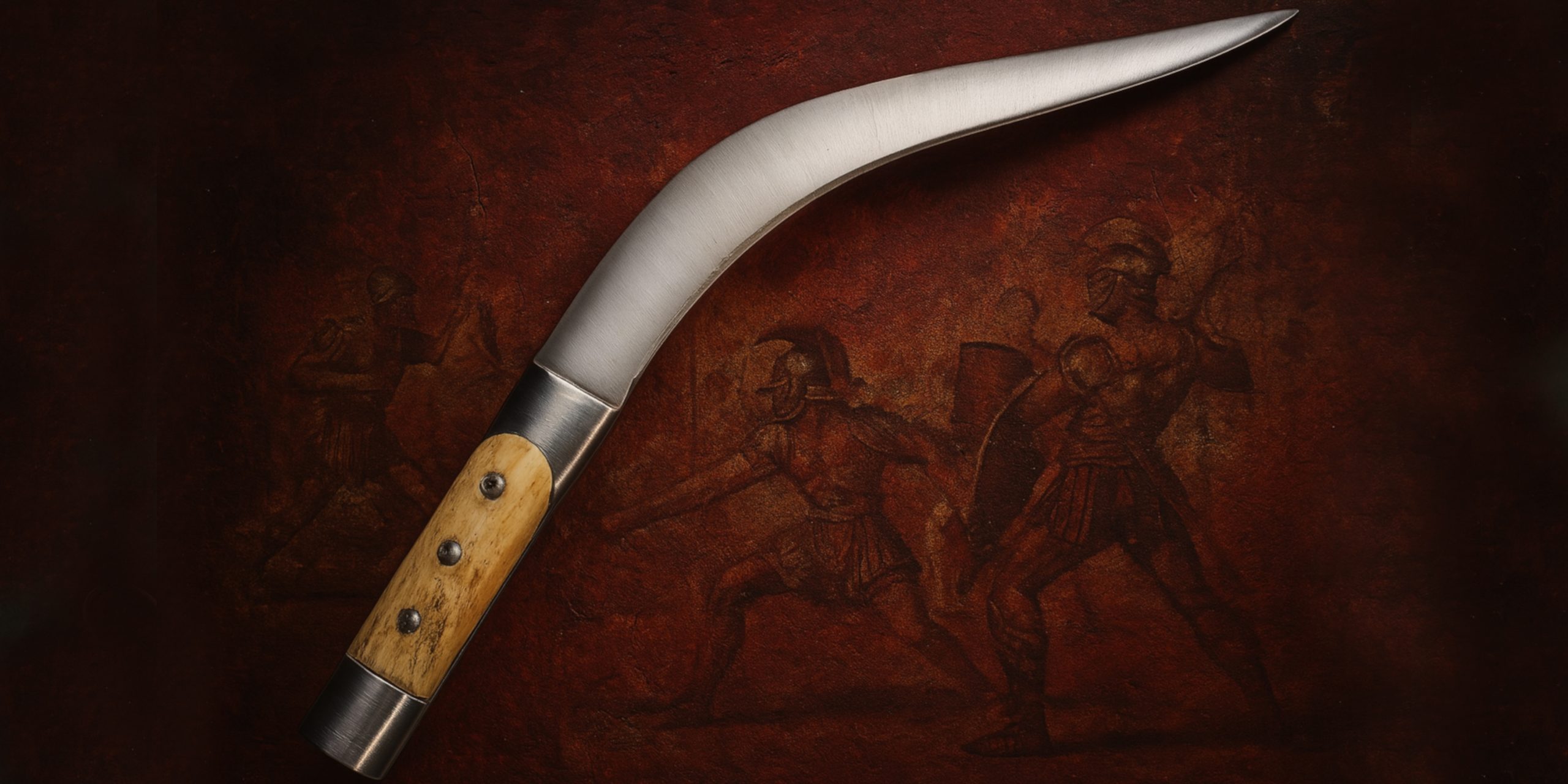
The sica was a short, curved sword primarily associated with the Thracians, Dacians, and later Roman gladiators. Its defining trait was its inward curve, designed to bypass shields and strike at exposed limbs. Although often linked with gladiatorial combat, the sica’s roots lie in tribal warfare across the Balkans and Eastern Europe.
Specifications
| Feature | Details |
|---|---|
| Type | Curved short sword |
| Blade Length | 16 to 18 inches (40 to 45 cm) |
| Overall Length | Up to 21 inches (53 cm) |
| Blade Curve | Pronounced inward (concave) |
| Material | Iron or steel |
| Hilt | Simple, usually wooden or bone-gripped |
| Edge | Single-edged |
| Point | Tapered for thrusting and slashing |
| Weight | Approx. 0.5 to 0.9 kg |
History and Evolution
- Thracian Origins: The sica originated in Thrace (modern-day Bulgaria and parts of Greece and Turkey) as early as the 4th century BC. It was a practical weapon in guerrilla-style combat in forested and mountainous regions.
- Dacian Use: Dacian warriors used variants of the sica alongside the larger falx. These curved weapons were effective against Roman armour, leading to tactical and equipment changes in the Roman military.
- Roman Gladiators: The sica became iconic in the hands of the gladiator type known as the Thraex. In the arena, it was used to hook and stab around an opponent’s shield.
- Cultural Spread: While most common in the Balkans and Roman provinces, archaeological finds suggest sica-like blades appeared throughout parts of Eastern Europe and even into North Africa.
Advantages and Disadvantages
Advantages:
- Effective at bypassing shields and armour gaps
- Compact and quick, ideal for close quarters
- Unconventional arc gave it an element of surprise
Disadvantages:
- Limited reach compared to straight swords
- Less effective in formation fighting
- Curved blade harder to maintain and forge
Comparison with Similar Weapons
| Weapon | Origin | Blade Type | Primary Use | Comparison with Sica |
|---|---|---|---|---|
| Gladius | Roman | Straight | Thrusting and slashing | Gladius was more versatile in formation use |
| Kopis | Greek | Forward-curved | Heavy chopping | Kopis was heavier and longer, better for cavalry |
| Falx | Dacian | Two-handed | Armour-piercing cuts | Falx had greater reach but lacked sica’s agility |
| Kukri | Nepalese | Curved | Utility and combat | Kukri is similar in curve but broader and heavier |
Legacy
The sica’s influence can be seen in the evolution of curved blades across multiple cultures. Its battlefield utility may have faded with changing tactics, but its symbolism endured. It came to represent treachery or assassination in Roman literature due to its association with assassins and gladiators.
Roman historian Cassius Dio mentioned the sicarii, a group of Jewish zealots known for carrying concealed sicae during the Roman occupation of Judea, giving the weapon a darker political legacy.
Where to See
You can view original sica swords or reconstructions in several museums:
- National Museum of History, Sofia (Bulgaria)
- National Museum of Romanian History, Bucharest
- British Museum, London
- Römisch-Germanisches Museum, Cologne
- Capitoline Museums, Rome
These often include both battlefield and gladiatorial variants.
Collector’s Guide
Rarity: Authentic sicae are relatively rare, especially those with intact hilts or scabbards.
Condition Factors:
- Metal integrity (corrosion or restoration)
- Provenance (battlefield or gladiatorial)
- Accompanying documentation
Auction Prices:
| Type | Estimate Range |
|---|---|
| Gladiatorial Roman Sica | £5,000 to £12,000 |
| Thracian/Dacian Battlefield | £7,000 to £15,000 |
| Fragmented Blade Only | £800 to £2,500 |
| High-end Reproductions | £150 to £600 |
Tips for Collectors:
- Verify provenance with reputable dealers
- Look for auction records via houses like Bonhams, Christie’s, or Hermann Historica
- Ensure storage in climate-controlled conditions to prevent further corrosion
The sica remains a significant piece of martial history, reflecting the ingenuity of regional warfare and the theatrics of Roman blood sport. While not as widely known as the gladius or spatha, its design and impact endure in collections and historical studies alike.



